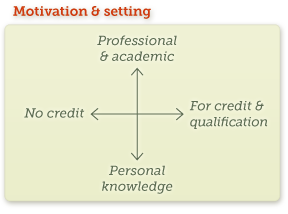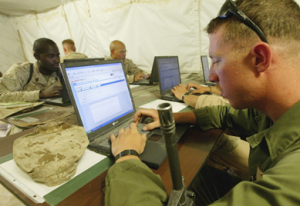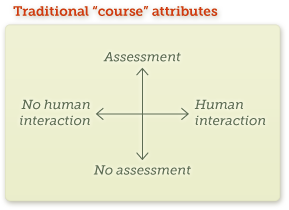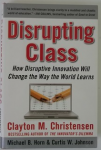Community Embraces New Word Game at Mid-Year Play Day This past Sunday, families at Takoma Park’s Seventh Annual Mid-Year Play Day had the opportunity to experience OtherWordly for the first time. Our educational language game drew curious children and parents to our table throughout the afternoon. Words in Space Several children gathered around our iPads […]
Read more
“The debate about which is better, face-to-face learning or online learning is fast becoming obsolete,” says Jennifer Berghage, an instructional designer at Pennsylvania State University. The common goal is that “an online course should be, above all, engaging, so that the learner enjoys the learning and is able to not only assimilate it but retain it and apply it.”
Online courses are revolutionizing formal education, and have opened a new genre of outreach on cultural and scientific topics. These courses deliver a series of lessons to a web browser or mobile device, to be conveniently accessed anytime, anyplace.
An “online course is designed as a built environment for learning. It’s constructed as an experience that can be followed sequentially or can be accessed throughout the designated time period,” says Wendy Woon, director of education at the Museum of Modern Art.

It’s a directed learning process, comprised of educational information (articles, videos, images, web links), communication (messaging, discussion forums) and some way to measure students’ achievement.
“There is no single formula for what constitutes an excellent online course,” says Berghage, though in good courses the “student feels a great sense of community and investment in the endeavor.” But an online course is more than the presentation of information or lectures. “Online courses require interaction, direction, and feedback,” says Jean Mandernach, a psychology professor and director of the Center for Innovation in Research and Teaching at Grand Canyon University.
The following are some overall dimensions to consider for teaching your target audience or professionals in your field, and possibly creating a new revenue stream.
 Academic/professional
Academic/professional
In academic (K-12 and higher ed) and professional (e.g., continuing education) settings, the student’s primary motivation is to advance their professional or academic career. Courses are designed around the objectives of the school administration.
 The number of students in kindergarten through 12th grade in the U.S. taking an online course as part of their school was estimated by the U.S. Dept. of Education to be 1.8 million enrollments in 2009-10, 74% of which was High School. Of those, 62% were to recover course credits from classes missed or failed, 47% were dual High School and college credit, 29% were AP, and 27 were career and technical education. In Canada, ~4% of K–12 students were engaged distance education. Full time K-12 cyber schools are also gaining popularity, currently estimated to be 225,000 in the U.S. In China, more than 200 online schools serve 600,000+ students (iNACOL PDF).
The number of students in kindergarten through 12th grade in the U.S. taking an online course as part of their school was estimated by the U.S. Dept. of Education to be 1.8 million enrollments in 2009-10, 74% of which was High School. Of those, 62% were to recover course credits from classes missed or failed, 47% were dual High School and college credit, 29% were AP, and 27 were career and technical education. In Canada, ~4% of K–12 students were engaged distance education. Full time K-12 cyber schools are also gaining popularity, currently estimated to be 225,000 in the U.S. In China, more than 200 online schools serve 600,000+ students (iNACOL PDF).

Soldiers stationed overseas can complete their coursework via online courses.
Enrollment is higher for higher-ed, where 31% of U.S. students (over 6.1 million students) took at least one course online in fall 2010, and annual growth continues at ~10%. Some higher-ed degree programs are entirely bought online, and are ranked by U.S. News. For-profit institutions such as University of Phoenix, DeVry University, and American Public University draw the highest enrollments, and have helped scare and propel the industry online, but have not yet earned academic respect.

Social studies teacher in a recorded video.
For academic online courses to work, parents and students have to be extremely self motivated. “Unfocused, passive learners do much better in an environment where the adult owns the responsibility for the learning,” says David Haglund, Principal of the Riverside Virtual School.
Some K-12 school systems create their own courses, but most contract them from private companies like K12, and Connections Academy, a unit of Pearson. Some courses are fantastic, but many are poor, or worse. The NYT drew attention to the shortcomings of online learning and of K12 last month in “Profits and Questions at Online Charter Schools,” and the WSJ recently profiled two families using virtual schools, with and without success. In higher-ed there are also commercial providers, e.g., Straighterline charges $99 to register for a month, plus $39 a course, and thousands of less-selective schools now accept 23 of their accredited courses for transfer credit.

Professional learning and continuing education are great for online courses because students are motivated and focused. Startups like Treehouse, CodeAcademy, Lynda.com target the professional skills market. Training marketplace OpenSesame aggregates training content from 100+ providers with 10,000+ courses. “We’re creating Amazon.com for courses,” said Tom Turnbull VP at OpenSesame.
Personal learning & happy students
For outreach, the best models of online courses are coming from the realm of personal learning. These courses are free of the constraints of K-12 and higher education, and are designed to delight and satisfy students.
 Substantial numbers of learners have taken online courses offering personal knowledge. This kind lifelong learning is for “anyone who wants to continue learning and building new skills once their formal education is done — no matter where they live, what their degree of education, how old they are, or whether they do it formally in the classroom or use less traditional resources,” says Dan Colman, founder of Open Culture and director of the Continuing Studies program at Stanford.
Substantial numbers of learners have taken online courses offering personal knowledge. This kind lifelong learning is for “anyone who wants to continue learning and building new skills once their formal education is done — no matter where they live, what their degree of education, how old they are, or whether they do it formally in the classroom or use less traditional resources,” says Dan Colman, founder of Open Culture and director of the Continuing Studies program at Stanford.
 There’s an expanding market for personal learning. DailyPath delivers “actionable lessons” by email, MightyBell lets users post experiences and goals that others can achieve by completing a series of steps. Craftsy offers delightful video-based courses on crafty topics.
There’s an expanding market for personal learning. DailyPath delivers “actionable lessons” by email, MightyBell lets users post experiences and goals that others can achieve by completing a series of steps. Craftsy offers delightful video-based courses on crafty topics.

Credit or not
Credit introduces many constraints, with standardized curricula, accreditation, and requirements to work with the ‘learning management systems” large institutions use to manage students and teachers. When credit is offered, the course builds toward student’s graduation, qualification or long-term career goals, thus, students (or whomever funds their education) are willing to pay substantial enrollment fees, and endure crummy experiences.
 If credit and grading are not a concern, there’s a lot more flexibility. Several schools have been experimenting with putting quality audio and video recordings of charismatic professors from top colleges online. These can be viewed in a web page (e.g., YouTube), or downloaded to listen later (as iTunes podcasts). iTunes makes it easy for learners to access 350,000+ free lectures, videos, films, and other educational resources. To find the gems, Colman’s Open Culture site indexes 400 free online courses from top universities.
If credit and grading are not a concern, there’s a lot more flexibility. Several schools have been experimenting with putting quality audio and video recordings of charismatic professors from top colleges online. These can be viewed in a web page (e.g., YouTube), or downloaded to listen later (as iTunes podcasts). iTunes makes it easy for learners to access 350,000+ free lectures, videos, films, and other educational resources. To find the gems, Colman’s Open Culture site indexes 400 free online courses from top universities.
Stanford Engineering professors recently offered three of the school’s most popular computer science courses for free online in Fall 2011. These included assignments and online discussion, and thousands of students who completed the course received a statement of accomplishment.
 Measuring up
Measuring up
In formal learning, assessment is the currency of progress. Good scores on assignments and tests are central. Creative teachers have invented other ways to assess learning, often by having students create projects and presentations.
 Assessment is more challenging in a virtual world, where it’s harder to measure quantitative and intangible aspects of learning, and it’s easy for student to cheat with conventional assessments. Assessment should include “intangible aspects, and should also offer multiple means of demonstrating learning, including individual and group projects and online presentations,” says Liz Pape, president of VHS, a nonprofit virtual school and consultancy.
Assessment is more challenging in a virtual world, where it’s harder to measure quantitative and intangible aspects of learning, and it’s easy for student to cheat with conventional assessments. Assessment should include “intangible aspects, and should also offer multiple means of demonstrating learning, including individual and group projects and online presentations,” says Liz Pape, president of VHS, a nonprofit virtual school and consultancy.
The more interesting question is how to incorporate assessment into personal learning, when there’s no credit. Assessment, if done in an appealing way, can encourage students, help them track their progress, and gain a sense of accomplishment. See my recent article on gamification for a variety of ideas on how to follow student’s achievements and progress.
Assessment is also vital feedback loop so you can improve your course.
Human touch
The more human, or human-like interaction the better.
 With the instructor — Feedback from the instructor on an essay, assignment or quiz, or answers to questions prompted from a lecture. Online, the feedback can be private (by email or direct message), or public (discussion forum). The instructor can moderate the online discussions, “inserting some comments into the discussions to keep students on task, add clarity to a discussion, or ask another question to get students to think deeper,” says Pape.
With the instructor — Feedback from the instructor on an essay, assignment or quiz, or answers to questions prompted from a lecture. Online, the feedback can be private (by email or direct message), or public (discussion forum). The instructor can moderate the online discussions, “inserting some comments into the discussions to keep students on task, add clarity to a discussion, or ask another question to get students to think deeper,” says Pape.
 With other students — Students can interact with the rest of their cohort in the discussion areas of a course. “This kind of course cannot be self-paced, because you need all the students interacting together around the course content at approximately the same time,” says Pape. Students enjoy working with other classmates in discussions, or perhaps group projects. Online discussion allows more students to discuss than could in a short in-person class, gives a space for timid students to speak up, and helps mute overbearing or bullying students.
With other students — Students can interact with the rest of their cohort in the discussion areas of a course. “This kind of course cannot be self-paced, because you need all the students interacting together around the course content at approximately the same time,” says Pape. Students enjoy working with other classmates in discussions, or perhaps group projects. Online discussion allows more students to discuss than could in a short in-person class, gives a space for timid students to speak up, and helps mute overbearing or bullying students.
A personal style — Lectures should give a personal feel, as if directly talking to the student via video chat. One approach is to use second-person phrases that directly address “you” the student, as in, “Now I’m going to show you…” and “so you’ve made a new discovery, that…” Use of second person has a long history in guidebooks, self-help books, do-it-yourself manuals, and other forms of writing that intend to address the reader without the instructor actually being present. Likewise, online assessment can lend a human touch, “Nice job! You got 3/4 correct!”

The sky’s the limit?
There are some practical limits. For example, an instructor can only provide personalized feedback to a relatively small number of students. Five minutes per question, for 25 student questions, is over two hours of work. If the feedback requires more critical analysis, online teaching quickly becomes a full time job. There are also practical limits as to the size of online discussion communities. Too small, and there’s no discussion, but over a few hundred students, and conversation gets swamped. For some courses, it’s appropriate to answer the most popular questions. Google’s moderator service allows students to vote on the most popular questions, allowing thousands of students to participate in choosing questions. Questions about assignments or technical issues can be public questions.
Despite these scalability hiccups, growth of all kinds of online courses will be explosive. The big money will be in for-credit courses, but there’s still huge potential for personal knowledge courses in areas of arts, culture and science.
 Harvard professor Clay Christensen, well-known for his academic work on disruptive innovations, wrote a book, Disrupting Class, looking at changes in how people learn. In a recent interview, he said:
Harvard professor Clay Christensen, well-known for his academic work on disruptive innovations, wrote a book, Disrupting Class, looking at changes in how people learn. In a recent interview, he said:
I think that not only are we ready but adoption is occurring at a faster rate than we had thought… We believe that by the year 2019 half of all classes for grades K-12 will be taught online… The rise of online learning carries with it an unprecedented opportunity to transform the schooling system into a student-centric one that can affordably customize for different student needs by allowing all students to learn at their appropriate pace and path, thereby allowing each student to realize his or her fullest potential….”
Sources: Lede robot illustration adapted from Stanford School of Engineering Initiative.
8 comments on What is an online course?
Comments are closed.


24 Jan 2012, 11:17 am
[…] They can be small and highly personal, or scale to thousands of students. As followup to my post about “What is an online course?”, let’s look behind the scenes at a few kinds of successful online classes, rich with video, […]
24 Jan 2012, 3:46 pm
[…] They can be small and highly personal, or scale to thousands of students. As followup to my post about “What is an online course?”, let’s look behind the scenes at a few kinds of successful online classes, rich with video, […]
23 Jul 2012, 9:49 am
I must say I have been considering taking online courses for some time now. I want to study in Scandinavia, but I'm temporarily not able to leave my country. There is no doubt face-to-face learning is possibly more effective, though it also depends on many things. Online courses, if not already, will soon be able to completely replace stationary learning. For some people it will probably be the only available form of education that's why it is important to make it as popular as possible and to improve it constantly.
09 Nov 2012, 5:45 pm
[…] learning uses online courses and materials to teach students. A pure online course creates a digital environment to teach […]
19 Nov 2012, 8:28 am
[…] What is an online course? – http://www.idea.org/2012/01/11/what-is-an-online-course/ […]
22 Apr 2013, 2:55 pm
[…] some more background, see also our articles on “What is an online course?” (Jan 2012), “Online courses for learning skills: MoMA, NYT & knitting” (Jan […]
22 Aug 2013, 12:18 pm
[…] what could be considered "online learning" is getting harder to strictly define. Idea.org challenges us to describe a typical online course. With a variety of existing courses that are […]
21 Apr 2015, 11:20 am
http://www.edutopia.org/blog/blended-online-learning-heather-wolpert-gawron